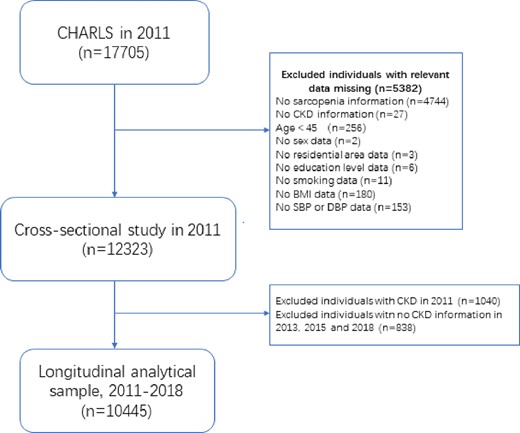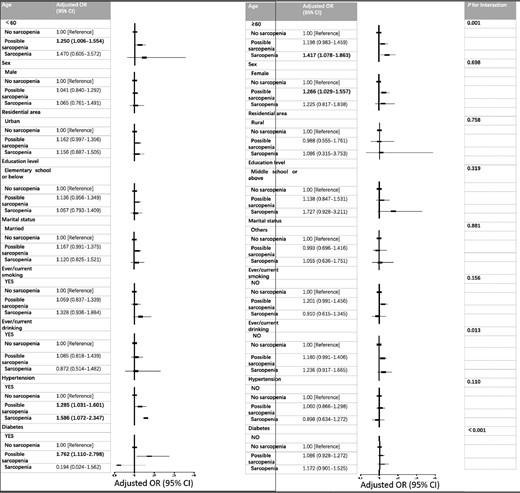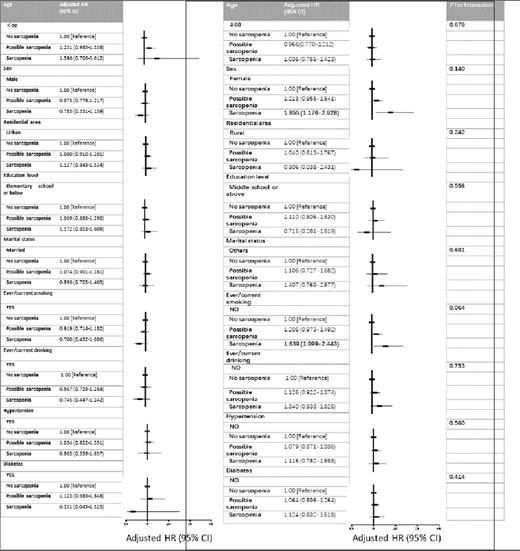-
PDF
- Split View
-
Views
-
Cite
Cite
Fang Liu, Yuan Jiamin, #986 Sarcopenia and chronic kidney disease among adults over 45 years old: findings from CHARLS, Nephrology Dialysis Transplantation, Volume 39, Issue Supplement_1, May 2024, gfae069–0579–986, https://doi.org/10.1093/ndt/gfae069.579
Close - Share Icon Share
Abstract
Little is known about the association between sarcopenia and chronic kidney disease (CKD) among Chinese adults older than 45. The present study sought to investigate the relationship between sarcopenia and CKD based on a large, nationally representative survey.
The China Health and Retirement Longitudinal Study (CHARLS) provided data for the study in four waves in 2011, 2013, 2015, and 2018. Based on the Asia Working Group for Sarcopenia 2019 (AWGS 2019) criteria, sarcopenia and possible sarcopenia were defined. CKD was defined as eGFR less than 60 mL/min/1.73 m2, calculated according to the CKD Epidemiology Collaboration (CKD-EPI) equation, or self-reported CKD. Logistic regression models were conducted to analyze the cross-sectional relationship between sarcopenia and CKD. Cox proportional hazards regression models were used to examine the effect of sarcopenia on CKD. Stratified analyses were used to assess the association between sarcopenia status and CKD in various subgroups.
Totally, 12323 participants over 45 years old (48.2% males; mean age 59.3 ± 9.5 years) were enrolled in a cross-sectional study in 2011, and further 10445 individuals were followed up in 2013, 2015 and 2018. The prevalence of CKD was 8.4% (1040/12323) in general populations, 7.2% (556/7703) in individuals without sarcopenia, 10.1% (380/3760) in adults with possible sarcopenia, and 12.1% (104/860) in individuals with sarcopenia, respectively. In cross-sectional study, possible sarcopenia [OR (95% CI): 1.236 (1.069-1.430)] was significantly associated with CKD (P < 0.01). While sarcopenia was not significantly associated with CKD. 783 cases (7.5%) with incident CKD events were identified during the 7 years of follow-up. In subgroup analyses, the incidence of CKD was 1.855 (95% CI 1.176-2.928) in the sarcopenia group compared with non-sarcopenia group among the female participants. The sarcopenia group (HR: 1.639, 95% CI 1.099-2.443) was independently associated with a higher incidence of CKD among non-smokers. Low muscle mass alone was not significantly associated with an increased risk of incident CKD (P > 0.05).
In our cross-sectional analysis, possible sarcopenia determined by AWGS2019 criteria was associated with a higher prevalence of CKD. In our longitudinal study, sarcopenia assessed using AWGS2019 criteria was associated with a higher risk of CKD in Chinese women over 45 years old or non-smokers.

Flow diagram for participants included in the study. Abbreviation: CKD, chronic kidney disease; BMI, body mass index; SBP, systolic blood pressure; DBP, diastolic blood pressure.

Subgroup analyses of the association between sarcopenia status and prevalence of CKD. Model adjusted for age, sex, residence, marital status, educational level, smoking status, drinking status, BMI, systolic blood pressure, diastolic blood pressure and comorbidities. Stratification variables were not adjusted in the corresponding models.

Subgroup analyses of the association between sarcopenia status and incidence of CKD. Model adjusted for age, sex, residence, marital status, educational level, smoking status, drinking status, BMI, systolic blood pressure, diastolic blood pressure and comorbidities. Stratification variables were not adjusted in the corresponding models.







Comments